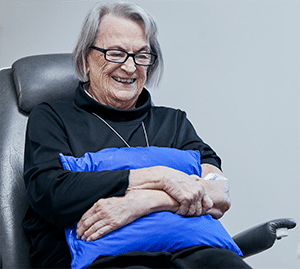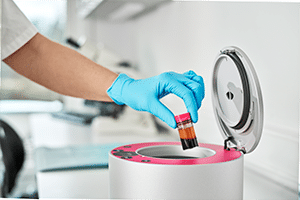Alison Musgrove
Advanced Podiatrist Alison Musgrove is one of the clinical practitioners that took part in the clinical trial. She kindly agreed to share her experience in the study, including details about patient selection, trial procedures, patch production, and treatment application.
CAN YOU TELL US ABOUT YOUR EXPERIENCE WORKING WITH PATIENTS SUFFERING FROM FOOT ULCERS IN A SPECIALIST DIABETIC FOOT CLINIC?
I am an advanced podiatrist in diabetes working in the specialist MDT diabetic foot clinic and have been in this role for 20 years. The clinic runs four days a week with around 35 people seen each, and a caseload of about 300 patients at any one time.
Over the period I have worked in such clinics I have seen few robust, evidence-based treatments being introduced, but it does feel as though this is beginning to change now. There appears to be more research being carried out that we can draw on to determine what treatments may or may not be effective for different cases.
WHAT WAS YOUR ROLE IN THE RANDOMISED CONTROLLED TRIAL?
I was in charge of patient selection, informed consent, trial procedures, blood taking, wound preparation, patch production and application.

HOW DID PATIENTS REACT TO BEING PART OF A STUDY WHERE THEIR OWN BLOOD IS BEING USED TO TREAT THEIR FOOT ULCERS?
On speaking to people on their willingness to participate in the trial, the comments were largely positive, and they were intrigued about trying such a novel way of treating their foot ulcer. The main concerns were that they would not get the intervention of the patch. The only declination in terms of having blood taken and used came from those with needle phobias and one on religious grounds.
“If you were selected to have the 3C Patch® treatment it would involve using your own active white blood cells, with nothing added to them. They will be made into a patch to cover your ulcer, under your usual dressing. This is in an attempt to understand if this is better for healing ulcers than the dressings alone. This will mean that we will take some of your blood at each visit and spin it in a centrifuge to separate the white from the red blood cells, which are then pressed in the centrifuge to make the patch.“
We would show the person the size of the pot used for their blood to give them an idea of the amount we would be taking.

CAN YOU COMMENT ON THE EVOLUTION OF THE PATIENTS IN THE 3C PATCH® GROUP AND YOUR EXPERIENCE WITH PREPARING AND APPLYING THE 3C PATCH® TREATMENT?
The sites and causes of ulceration varied considerably in the trial participants, however according to protocol they were deemed hard to heal and greater than a cm square at inclusion.
The off-loading of all ulcers is paramount in the treatment of diabetic foot, and off-loading plantar wounds presents a far greater challenge. Those ulcers not subject to pressure reduced in size rapidly with the weekly use of 3C Patch® treatment with no subsequent infection throughout the trial.
The improvement of all wounds in the group was greater than may have been expected with usual care.
The patch production was not without difficulties – particularly as one of the patients was very difficult to take blood from and another had coagulation issues. However, once experience was gained over the course of the trial, the patch production became a simple process taking little more time than a regular appointment at the clinic. The introduction post trial of the new centrifuge with coagulation sensors further speeds up the visit, as the clinician no longer has to check for this process to occur, and can be carrying out tasks such as debridement and patient education whilst the patch is produced.
*3C Patch® is formerly known as LeucoPatch
REFERENCES
[1] Game F., Jeffcoate W., Tarnow L., Jacobsen JL., Whitham DJ., Harrison EF., Ellender SJ., Fitzsimmons D., Löndahl M., LeucoPatch system for the management of hard-to-heal diabetic foot ulcers in the UK, Denmark, and Sweden: an observer-masked randomized controlled trial. www.thelancet.com/diabetes-endocrinology. Published online September 19, 2018 https://dx.doi.org/10.1016/S2213-8587(18)300240.
